
Parmelia is a genus of medium to large foliose (leafy) lichens. It has a global distribution, extending from the Arctic to the Antarctic continent but concentrated in temperate regions. There are about 40 species in Parmelia. In recent decades, the once large genus Parmelia has been divided into a number of smaller genera according to thallus morphology and phylogenetic relatedness.

Peltigera is a genus of approximately 100 species of foliose lichens in the family Peltigeraceae. Commonly known as the dog or pelt lichens, species of Peltigera are often terricolous, but can also occur on moss, trees, rocks, and many other substrates in many parts of the world.
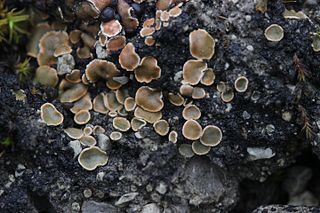
Psora is a genus of lichen-forming fungi in the family Psoraceae. Members of the genus are commonly called fishscale lichens. Lichens in the genus Psora generally have a squamulose thallus and anthraquinones in the hymenium. Photobiont partners of Psora lichens include members of the green algal genera Asterochloris, Chloroidium, Myrmecia, and Trebouxia.
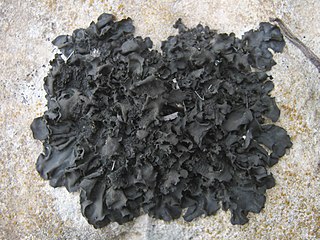
Collema is a genus of lichens in the family Collemataceae. The photobiont is the cyanobacterium genus Nostoc. Species in this genus typically grow on nutrient-rich bark or somewhat siliceous or calcareous rocks in humid environments.

Lecanora is a genus of lichen commonly called rim lichens. Lichens in the genus Squamarina are also called rim lichens. Members of the genus have roughly circular fruiting discs (apothecia) with rims that have photosynthetic tissue similar to that of the nonfruiting part of the lichen body (thallus). Other lichens with apothecia having margins made of thallus-like tissue are called lecanorine.

Ramalina is a genus of greenish fruticose lichens that grow in the form of flattened, strap-like branches. Members of the genus are commonly called strap lichens or cartilage lichens. Apothecia are lecanorine.

Sticta is a genus of lichens in the family Peltigeraceae. The genus has a widespread distribution, especially in tropical areas, and includes about 114 species. These lichens have a leafy appearance, and are colored brown or black. Sticta species with cyanobacteria as photobionts can fix nitrogen from the atmosphere, and due to their relative abundance and high turnover, they contribute appreciably to the rainforest ecosystem. They are commonly called spotted felt lichens.

Leptogium is a genus of lichen-forming fungi in the family Collemataceae. It has about 110 species. Species formerly classified under Leptogium have since been divided among the genera Leptogium, Pseudoleptogium, and Scytinium. Leptogium lichens are predominantly found on tree bark or soil, often among mosses, and sometimes on rocks in moist environments.
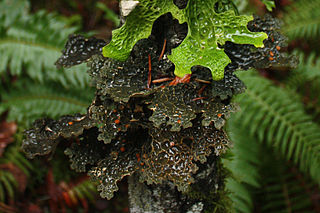
Pseudocyphellaria is a genus of large, leafy lichens that are sometimes referred to as "specklebelly" lichens. The genus has a widespread distribution, especially in south temperate regions, and contains about 170 species. They resemble Lobaria, except that most species of Pseudocyphellaria have conspicuous pseudocyphellae on their lower surface, a characteristic that was once considered unique to this genus. Some species contain pulvinic acid-related pigments; in these species the soredia and pseudocyphellae can be bright yellow.

A cephalodium is a small gall-like structure found in some lichens. They occur only in lichens which contain both cyanobacterial and green algal partners. Cephalodia can occur within the tissues of the lichen, or on its upper or lower surface. Lichens with cephalodia can fix nitrogen, and may be an important contributor of nitrogen to the ecosystem.

A foliose lichen is a lichen with flat, leaf-like lobes, which are generally not firmly bonded to the substrate on which it grows. It is one of the three most common growth forms of lichens. It typically has distinct upper and lower surfaces, each of which is usually covered with a cortex; some, however, lack a lower cortex. The photobiont layer lies just below the upper cortex. Where present, the lower cortex is usually dark, but occasionally white. Foliose lichens are attached to their substrate either by hyphae extending from the cortex or medulla, or by root-like structures called rhizines. The latter, which are found only in foliose lichens, come in a variety of shapes, the specifics of which can aid in species identification. Some foliose lichens attach only at a single stout peg called a holdfast, typically located near the lichen's centre. Lichens with this structure are called "umbilicate". In general, medium to large epiphytic foliose lichens are moderately sensitive to air pollution, while smaller or ground-dwelling foliose lichens are more tolerant. The term "foliose" derives from the Latin word foliosus, meaning "leafy".

Lichens are symbiotic organisms made up of multiple species: a fungus, one or more photobionts and sometimes a yeast. They are regularly grouped by their external appearance – a characteristic known as their growth form. This form, which is based on the appearance of vegetative part of the lichen, varies depending on the species and the environmental conditions it faces. Those who study lichens (lichenologists) have described a dozen of these forms: areolate, byssoid, calicioid, cladoniform, crustose, filamentous, foliose, fruticose, gelatinous, leprose, placoidioid and squamulose. Traditionally, crustose (flat), foliose (leafy) and fruticose (shrubby) are considered to be the three main forms. In addition to these more formalised, traditional growth types, there are a handful of informal types named for their resemblance to the lichens of specific genera. These include alectorioid, catapyrenioid, cetrarioid, hypogymnioid, parmelioid and usneoid.

Lichen morphology describes the external appearance and structures of a lichen. These can vary considerably from species to species. Lichen growth forms are used to group lichens by "vegetative" thallus types, and forms of "non-vegetative" reproductive parts. Some lichen thalli have the aspect of leaves ; others cover the substrate like a crust, others such as the genus Ramalina adopt shrubby forms, and there are gelatinous lichens such as the genus Collema.
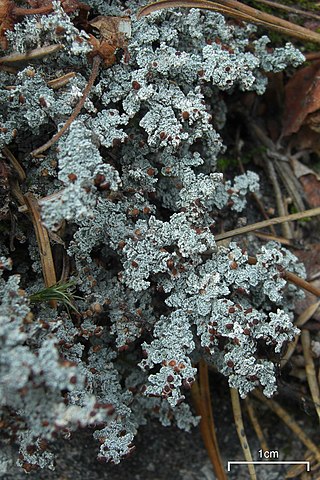
Stereocaulon is a genus of lichens. Members of Stereocaulon are commonly called rock foam lichens. Photobiont partners of Stereocaulon include green algae from the genera Asterochloris, Chloroidium, and Vulcanochloris. Stereocaulon is difficult to ID to species, but there is a high diversity of species within the genus.
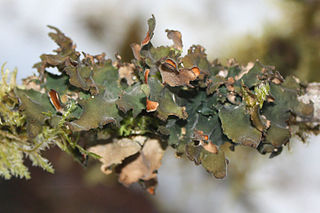
Nephroma resupinatum, commonly known as the pimpled kidney lichen, is a species of foliose lichen in the family Peltigeraceae. It was first described by Carl Linnaeus in his 1753 work Species Plantarum as Lichen resupinatus. Erik Acharius transferred it to the genus Nephroma in 1810.
Orvo Vitikainen is a Finnish lichenologist. He entered the University of Helsinki in 1961, from where he obtained a Candidate of Philosophy degree in 1966, and a Licentiate of Philosophy in 1971. He later earned a Ph.D. from this institution in 1994, under the supervision of Teuvo Ahti. Between the years 1961 and 1981 he was a junior curator of cryptogams at the University of Helsinki Botanical Garden, and then from 1983 to 2004 he was the head of the lichen herbarium. Here he managed the internationally valuable collections of the early lichenologists Erik Acharius and William Nylander. He has collected thousands of specimens for the herbarium from various locations in Finland, but also internationally, including Sweden, Norway, Denmark, Russian Karelia, Scotland, Austria, Italy, Hungary, Croatia, Montenegro, Tanzania, Kenya, British Columbia, and Brazil. In 1992–1994, he was a scientist of the Finnish Academy in the Ahti research group.
Yoshimuriella is a genus of foliose (leafy) lichens in the family Peltigeraceae. It has nine species.

Crocodia is a genus of foliose lichens in the family Peltigeraceae. It has eight species. The genus has a cosmopolitan distribution, although most species occur in temperate and tropical regions of the Southern Hemisphere. The main characteristics of the genus that separate it from its parent genus, Pseudocyphellaria, include a yellow medulla and yellow pseudocyphellae on the lower thallus surface.

Nephroma arcticum, the arctic kidney lichen, is a species of foliose (leafy), terricolous (ground-dwelling) lichen in the family Parmeliaceae. It has a yellowish-green thallus up to 8 cm (3 in) across made of large lobes, with a dark, tomentose lower surface. It is a tripartite lichen, consisting of a fungus and two photobiont partners: a species of nitrogen-fixing cyanobacteria, and a species of green alga. First described by Carl Linnaeus in 1753, it is one of only two Nephroma species in North America that use green algae as their primary photobiont.
Nephroma flavorhizinatum is a species of terricolous (ground-dwelling) foliose lichen in the family Peltigeraceae. Described as new to science in 2011, it is only known to occur in the Tibetan Plateau.

















